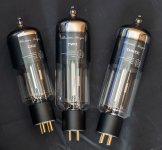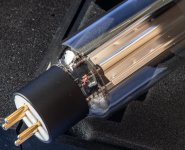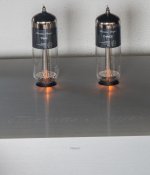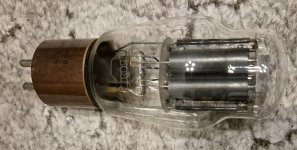Thomas Mayer has just released 3 new tubes, One, Two and Three with cylindrical plates. He makes a case for these sounding better.
I've read this opinion before, e.g. from directdriver -
"I find round plate small signal triodes offer the most pleasing sound, e.g. Tungsol 6SN7 with round plates. So I try to use 6J5 or 27, 37, 56, 76, 6P5 whenever possible at a much cheaper price. I always go for cylindrical over flat plate so two 6J5s instead of one 6SN7."
I also use 27, 37, 56, 76 as small signal tubes so no argument there. But I can think of many superb tubes like 10Y with flat anodes.
So what's the truth in this?
I've read this opinion before, e.g. from directdriver -
"I find round plate small signal triodes offer the most pleasing sound, e.g. Tungsol 6SN7 with round plates. So I try to use 6J5 or 27, 37, 56, 76, 6P5 whenever possible at a much cheaper price. I always go for cylindrical over flat plate so two 6J5s instead of one 6SN7."
I also use 27, 37, 56, 76 as small signal tubes so no argument there. But I can think of many superb tubes like 10Y with flat anodes.
So what's the truth in this?
From Thomas Mayer
"They have a single filament string in the center of the tube which is surrounded by a cylindrical spiral as grid and everything is surrounded by a cylindrical anode (plate). The anode has some added side wings for heat dissipation.This arrangement results in exceptional linearity and unsurpassed sound quality which make them the tubes of choice for the Intrepid series. These new tubes will be on demo at the Munich High End. Come to Hall 2, F06"



"They have a single filament string in the center of the tube which is surrounded by a cylindrical spiral as grid and everything is surrounded by a cylindrical anode (plate). The anode has some added side wings for heat dissipation.This arrangement results in exceptional linearity and unsurpassed sound quality which make them the tubes of choice for the Intrepid series. These new tubes will be on demo at the Munich High End. Come to Hall 2, F06"



I also use 27, 37, 56, 76 as small signal tubes so no argument there. But I can think of many superb tubes like 10Y with flat anodes.
So what's the truth in this?
What do you drive your drivers with?
The truth or reality is just an infinitesmally thin 6th side of the cube and all the interior volume is filled with subjectivity and perception mixed with agenda and bias. You have to step outside of the cube to see the side with the thruth.
Last edited:
Not available to the public - only in Thomas Mayer products. No spec sheets available at present and no indication that they will be available. Just a "for instance".Spec sheets? Prices?
These new tubes are just one example of cylindrical plates, however. So more interesting to look at the many existing tubes with a round anode structures.
I have the same opinion. 6F6, 6SL7 and now 6G6 are my picks.Thomas Mayer has just released 3 new tubes, One, Two and Three with cylindrical plates. He makes a case for these sounding better.
I've read this opinion before, e.g. from directdriver -
"I find round plate small signal triodes offer the most pleasing sound, e.g. Tungsol 6SN7 with round plates. So I try to use 6J5 or 27, 37, 56, 76, 6P5 whenever possible at a much cheaper price. I always go for cylindrical over flat plate so two 6J5s instead of one 6SN7."
I also use 27, 37, 56, 76 as small signal tubes so no argument there. But I can think of many superb tubes like 10Y with flat anodes.
So what's the truth in this?
I have always avoided the 6SN7 for 2 reasons: 1) too expensive 2) I have always been told they are more microphonic in comparison to other variants.
I suspect that round plates and “sound better” have more to do with older tubes and the sound they make. Many tubes started with round plates, maybe it made some calculations easier? I have heard that one of the reasons all of the companies moved away from round plates is that it cut down on manufacturing costs. If you are drawn to the sound of that generation of tubes you might ascribe it to the shape instead of other things that could be involved.
The round plate Tung Sol 6sn7 is widely considered the holy grail of that tube type. I haven’t noticed any better or worse sound from them. I’m more convinced that the hype around round plate tubes has to do with how easy they are to identify and thus easier to sell.
The round plate Tung Sol 6sn7 is widely considered the holy grail of that tube type. I haven’t noticed any better or worse sound from them. I’m more convinced that the hype around round plate tubes has to do with how easy they are to identify and thus easier to sell.
A sensible and informative comment, at last. There may or may not be any significant advantage to round anodes, but since this comes up anecdotally from time to time it seems worth asking the question.I suspect that round plates and “sound better” have more to do with older tubes and the sound they make. Many tubes started with round plates, maybe it made some calculations easier? I have heard that one of the reasons all of the companies moved away from round plates is that it cut down on manufacturing costs. If you are drawn to the sound of that generation of tubes you might ascribe it to the shape instead of other things that could be involved.
Thomas Mayer is a highly experienced engineer who has specialised in tube construction for many years - see his blogs on Vinylsavor dissecting many different kinds of tubes, and his recent years designing and manufacturing his own tubes. So his decision to use cylindrical construction is not without reason or weight.
The triode-connected pentodes have good linearity and have a tendency to generate visibly less high order harmonics. It's mostly second which can be dealt with easy. The 6F6 is the second quietest power tube I have ever found. The first is the 45 which has not got that geometry but simply a cracking design, IMHO.I second the above question: what do you mean by "sounds better"? What measured aspects of valve in what context sound "better" or "worth"?
Without that a discussion seems impossible.
Some of the triodes are simply linear. I say some because the older ones may have some consistency issues (accuracy and precision could not be great as it could be today). So they need some selection which might be possible only if one is lucky enough to have a good number.
Nonsense.Thomas Mayer has just released 3 new tubes, One, Two and Three with cylindrical plates. He makes a case for these sounding better.
I've read this opinion before, e.g. from directdriver -
"I find round plate small signal triodes offer the most pleasing sound, e.g. Tungsol 6SN7 with round plates. So I try to use 6J5 or 27, 37, 56, 76, 6P5 whenever possible at a much cheaper price. I always go for cylindrical over flat plate so two 6J5s instead of one 6SN7."
I also use 27, 37, 56, 76 as small signal tubes so no argument there. But I can think of many superb tubes like 10Y with flat anodes.
So what's the truth in this?
Most tubes have flat cathodes and box shaped anodes, with the long side of the anode equidistant from the cathode, and the grid wires are wound around the posts that fix the anode plates. The boxy structure creates a lot of parallel surfaces and the grid wiring is accurately positioned in that space. But thinking about it, the grid wiring is oval in section, so that could be the reason frame grid tubes are sought after.
If you have a round tube, to achieve the same accuracy it would have to be a cathode tube that is centralised perfectly in the anode, and how is the grid wiring going to be done so the winding posts do not impact the symmetry of the inside of the anode tube?
A lot of diodes have cylindrical anodes, so perhaps the grid wires are the complicating factor?
My feeling is that if there was a benefit in some way with cylindrical anodes that could have been used to gain a competitive advantage in the golden age of tubes, then there would be more examples.
If you have a round tube, to achieve the same accuracy it would have to be a cathode tube that is centralised perfectly in the anode, and how is the grid wiring going to be done so the winding posts do not impact the symmetry of the inside of the anode tube?
A lot of diodes have cylindrical anodes, so perhaps the grid wires are the complicating factor?
My feeling is that if there was a benefit in some way with cylindrical anodes that could have been used to gain a competitive advantage in the golden age of tubes, then there would be more examples.
Linear RF Tubes:
Many have cylindrical structures.
4-65A, 4x150, and a 1500Watt Linear Triode from Eimac (made for TV transmitters).
The distances of electron paths are all equal, so all the electrical fields are equal strength.
Cylindrical is the key.
Then there is the smaller tube, the 416A, with an all flat cathode, flat grid, and flat plate (each one is a flat circle).
The distances of electron paths are all equal, so all the electrical fields are equal strength.
Intrinsically, as long as care is taken in assembly, we have a linear tube.
Tubes that are sometimes linear, and sometimes not linear:
Flat 2 sided plates, oval grids and screens, flat or oval cathodes, etc.
The point is, all tubes have many surfaces. For many tubes, there are multiple different distances from one element to another element, the electron paths have many unequal lengths. That means the fields are not constant between any two elements.
The 45 has flat 2 sided plates. However, it is very linear. What might be the cause?
Take a look at your own 45 DHT. You will see that the grid windings are both Below the bottom of the plate, and Above the top of the plate.
There is no direct electron field from the filament to the plate, the overhanging grid wires get in the way.
Just my theory as to why the tube is linear.
The most linear tube, is not linear if you operate it above or below its linear region.
Your tubes, and your theories may vary.
Many have cylindrical structures.
4-65A, 4x150, and a 1500Watt Linear Triode from Eimac (made for TV transmitters).
The distances of electron paths are all equal, so all the electrical fields are equal strength.
Cylindrical is the key.
Then there is the smaller tube, the 416A, with an all flat cathode, flat grid, and flat plate (each one is a flat circle).
The distances of electron paths are all equal, so all the electrical fields are equal strength.
Intrinsically, as long as care is taken in assembly, we have a linear tube.
Tubes that are sometimes linear, and sometimes not linear:
Flat 2 sided plates, oval grids and screens, flat or oval cathodes, etc.
The point is, all tubes have many surfaces. For many tubes, there are multiple different distances from one element to another element, the electron paths have many unequal lengths. That means the fields are not constant between any two elements.
The 45 has flat 2 sided plates. However, it is very linear. What might be the cause?
Take a look at your own 45 DHT. You will see that the grid windings are both Below the bottom of the plate, and Above the top of the plate.
There is no direct electron field from the filament to the plate, the overhanging grid wires get in the way.
Just my theory as to why the tube is linear.
The most linear tube, is not linear if you operate it above or below its linear region.
Your tubes, and your theories may vary.
Marketing snake oilSo what's the truth in this?
why should there be?A sensible and informative comment, at last. There may or may not be any significant advantage to round anodes, but since this comes up anecdotally from time to time it seems worth asking the question.
Thomas Mayer is a highly experienced engineer who has specialised in tube construction for many years - see his blogs on Vinylsavor dissecting many different kinds of tubes, and his recent years designing and manufacturing his own tubes. So his decision to use cylindrical construction is not without reason or weight.
- Home
- Amplifiers
- Tubes / Valves
- Do cylindrical plate, round anode tubes sound better?
